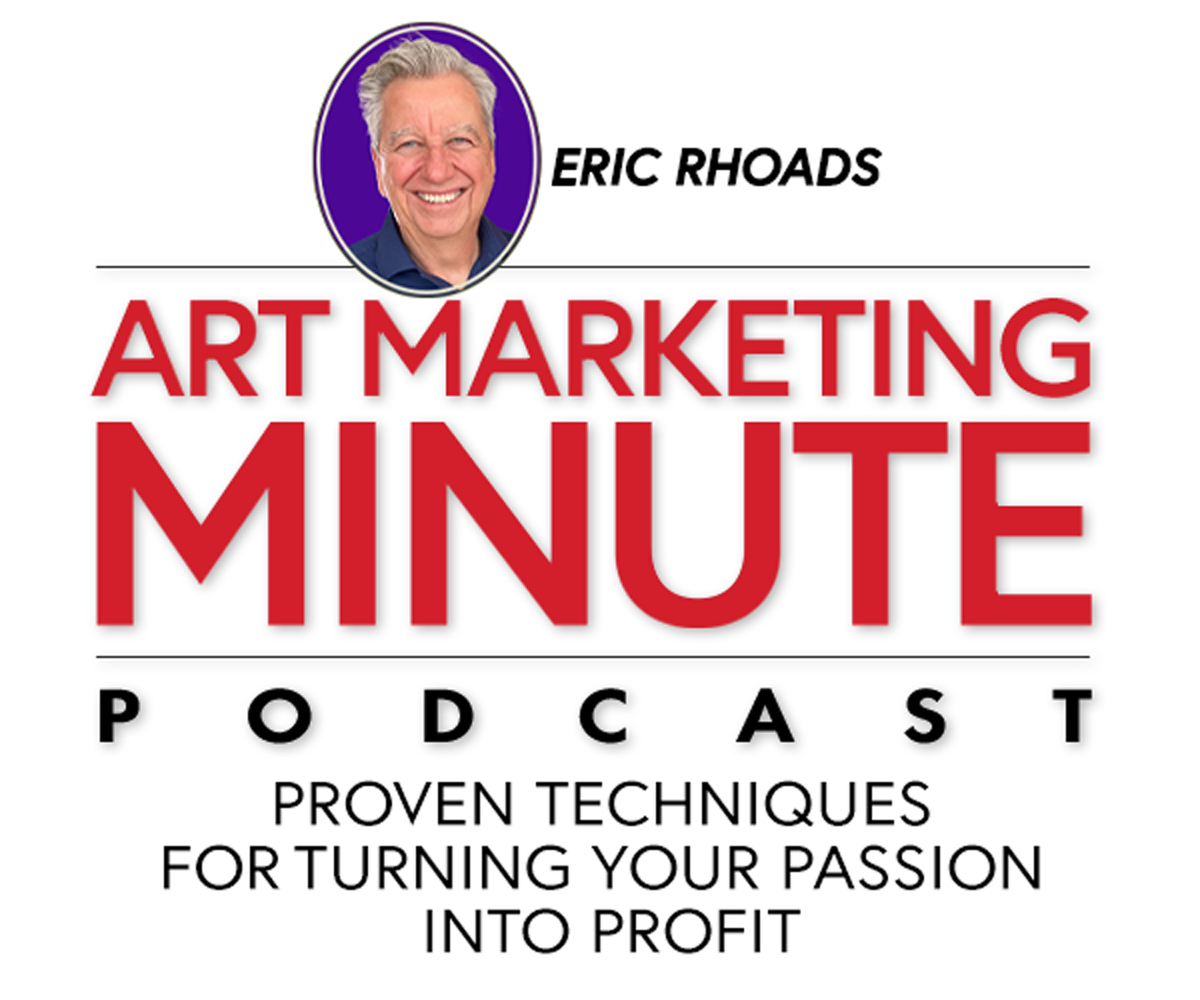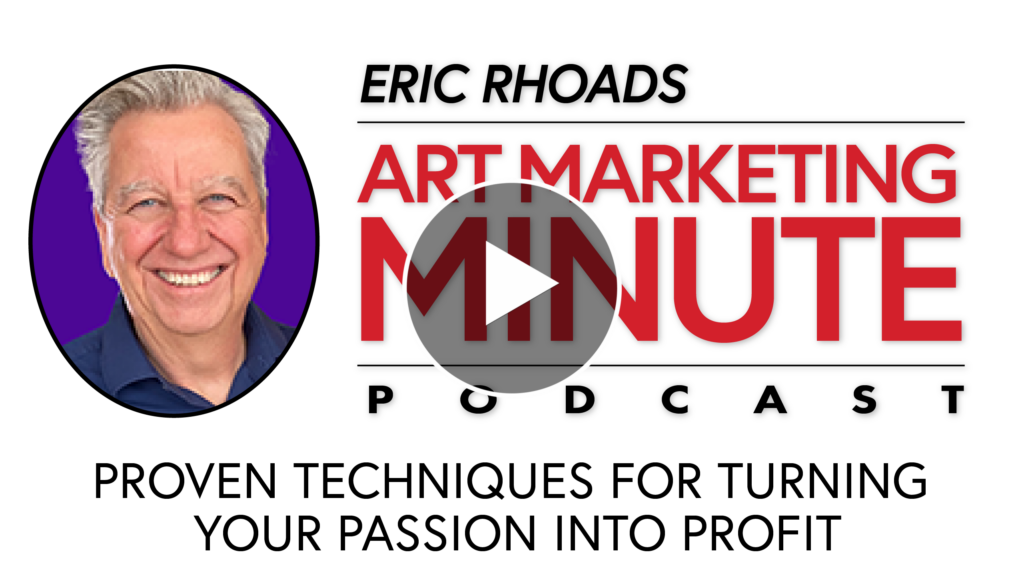Art Marketing Minute Podcast: Episode 62
In the Art Marketing Minute Podcast, you’ll learn how to sell your art, how to market your paintings, and everything else you need to know in order to have a successful art career. Each episode answers questions from artists by host Eric Rhoads, author of “Make More Money Selling Your Art,” publisher of several art magazines and newsletters, and author of ArtMarketing.com.
In this Art Marketing Minute, learn tips for finding (and creating) commission work, and hear feedback on whether social media should be your sole avenue for promoting your art.
Listen to the Art Marketing Minute Podcast: Episode 62 >
Submit Your Art Marketing Question:
What questions do you have about selling your art? Email Eric today at [email protected] (include your name and where you’re from) to hear your question answered on an upcoming Art Marketing Minute Podcast.
FULL TRANSCRIPT of the Art Marketing Minute:
DISCLAIMER: The following is the output of a transcription from an audio recording of the Art Marketing Minute. Although the transcription is mostly correct, in some cases it is slightly inaccurate due to the recording and/or software transcription.
Announcer:
This is the Art Marketing Minute with Eric Rhoads, author of the Amazon best selling book, “Make More Money Selling Your Art.” In the marketing minute we answer your questions to help your art career brought to you by artmarketing.com, the place to go to learn more about marketing. Now, here’s your host, arts magazine publisher, Eric Rhoads.
Eric Rhoads:
Here’s a question from Rachel Harris who attended the recent Realism Live online conference and her question is about commissions. She asked what’s the best way to find a market for commission work? By commissions she means doing paintings that people commissioned you to do. Right? That’s what I think she means anyway, start with this idea. First off, people don’t know the word commissions. It is not a term used by regular everyday people. If they think Commission’s they think like they’re getting a sales commission on something. So don’t confuse them. They don’t know the term, the best way to present it is to look at people who are lookers, let’s say you’re in a gallery environment, or they come to your studio, they’re looking around, you can drop a hint very subtly, say, by the way, if you don’t find something you like, we also can do some custom paintings of your favorite subjects or your favorite people. You know, sometimes people ask me to paint a deceased aunt or uncle or, or a brother or a family member or their kids, or their favorite vacation home. What you want to do is load their lips, you could say things like, Hey, have you ever been on a trip and you found like this place that totally inspired you, if you can get me a photograph of that I’ll create a beautiful big painting, any size you want, for you for your home of that particular subject, put the ideas in their head because they don’t think of it themselves. And then put it everywhere. Put it on your newsletter, your website in your ads, you know, ask me about creating custom paintings of your favorite subjects. Don’t use the word Commission’s also, it’s a good idea for your website, do a story on it, like, tug at their heartstrings a little bit, you know, like, Jane’s husband died, they were the happy couple. They lived together for 40 years. And, Jane remembers when they first met. And you know, Bob was 30. And she just loved him so much. And she found a photo of when he was 30. So she asked me to do a painting of it. So I did this painting of him when he was 30. And she just cherishes. It’s one of her favorite things. And so, you could talk about how that works. And then do a little story for your website or for your newsletter. And that’s a good thing. And remember, insider terms are things people don’t understand. Don’t use insider terms.
Now here’s a question from Mike Freelander in Scottsbluff. Nebraska. Hi, Mike. He says because social media is so big these days, it seems like I don’t need anything else. Do you agree? Well, I’m assuming Mike is saying I’m not sure ‘I need anything else for marketing’? Well, that’s a slippery slope, Mike, if you’re using it, and it’s selling as much work as you want it to sell, and it’s working for you. No, you don’t need anything else until it stops working. And the problem with that is there’s a thing called a single point of failure. So single point of failure, let’s say that you are flying an airplane, and it’s a single engine airplane, and that single engine goes dead. While you’re up at the 10,000 feet. What are you going to do? Well, if you have a twin engine airplane, you still have another engine to backup for you. The same is true in marketing. And this is a common problem. It’s something happens a lot. And that is that people have a single point of failure, they put all their money into a single marketing source. And suddenly, sometimes that single marketing source stops working or it dries up, or there’s regulation that changes everything a friend of mine was in the infomercial business. And the law changed in one day, he went from having a billion dollar business to having no business. And that’s because he had a single point of failure if he had other marketing things going on. So I like to think think of it as the Parthenon, I’ve talked about this in the past, think of the Parthenon, it has multiple columns. If you had the thing on the part that what do they call that thing on the same focusing on a single column. And that got hit by a car while the rest of the building would come down? Right. And so you want to have at least three columns, because it’ll make it more stable, but it’s better to have five or six columns, you want to spread your money around a little bit and it’s not necessarily right to spread it in appropriately. For instance, you can spread to many places to advertise. And then you’re not getting enough traction from what you’re doing. And that’s a whole nother topic. But you know, the reality is social media can be good. Some artists are telling me they’re selling some work from it. I don’t hear very often that artists are selling all their work on it. You know, you want to have a gallery or you want to have a direct marketing line. You want to have your your social media, you might want to have some advertising, you might want to have a lot of other things. You know, social media is great for getting leads, but it’s not great for getting buyers. Now there are again exceptions to that rule. And so what you want to do is say okay, how do I generate leads, how do I create something that I get a lead from spending that money. And then those were those leads can be warmed up and turned into a customer over time, what I find with most of my artists, friends, and most of the artists I deal with, and some that I’ve consulted with that most of them have their social media following or other artists. And they really don’t have a lot of known collectors known art buyers on there. As a result, when they post something or when they advertise, it’s not necessarily reaching the right people. So it’s very tricky. And so most people misuse social media and social media is a beautiful thing. Don’t get me wrong, I love it. It’s very effective. And it’s a good way to stay in touch with people and to put your work out there. It’s also a good way to be misunderstood because if you’re putting out you know, a lot of people put out unfinished paintings people don’t read, they think it’s finished, and they go, why would he post that it’s not very good. So, like all things though, my marketing philosophy is stand in the river where the money is flowing. And wherever the money is flowing, you need to be there. And for me, the money is flowing where there are massive amounts of known buyers of art people who are collectors of art who are who are archives of collectors. That’s why things like you know, my audiences that fine art kind of Sir plein air. Those are the river where the money’s flowing. Those people buy paintings, they buy lots of paintings, we sell tons of paintings through ads from various collectors if people have effective ads. And yes, you can employ social media, I use social media. I spent a lot of money on social media, but I use it very specifically. I very rarely ever get buyers from social media, I get leads and then I have to figure out how do I turn them into buyers. That’s a whole nother complicated subject. It’s, it’s something we can address on another day. But the bottom line is anything that’s working for you keep putting money after it and just know that everything dries up at some point. Sometimes it’s your own fault because you’re doing bad advertising or bad marketing. But you can change that. And so you want to constantly be monitoring what’s happening.
Well, this has been the art marketing minute with me. Eric Rhoads. My goal in life is to eliminate the idea of starving artists to help your dreams actually come true. So if you want to submit questions, simply email [email protected]. And to learn more about marketing ideas, you can visit Artmarketing.com. Thanks for listening.
How to Submit Your Art Marketing Questions: What questions do you have about selling your art? Email Eric today at [email protected] (include your name and where you’re from) to hear your question answered on an upcoming Art Marketing Minute Podcast.

